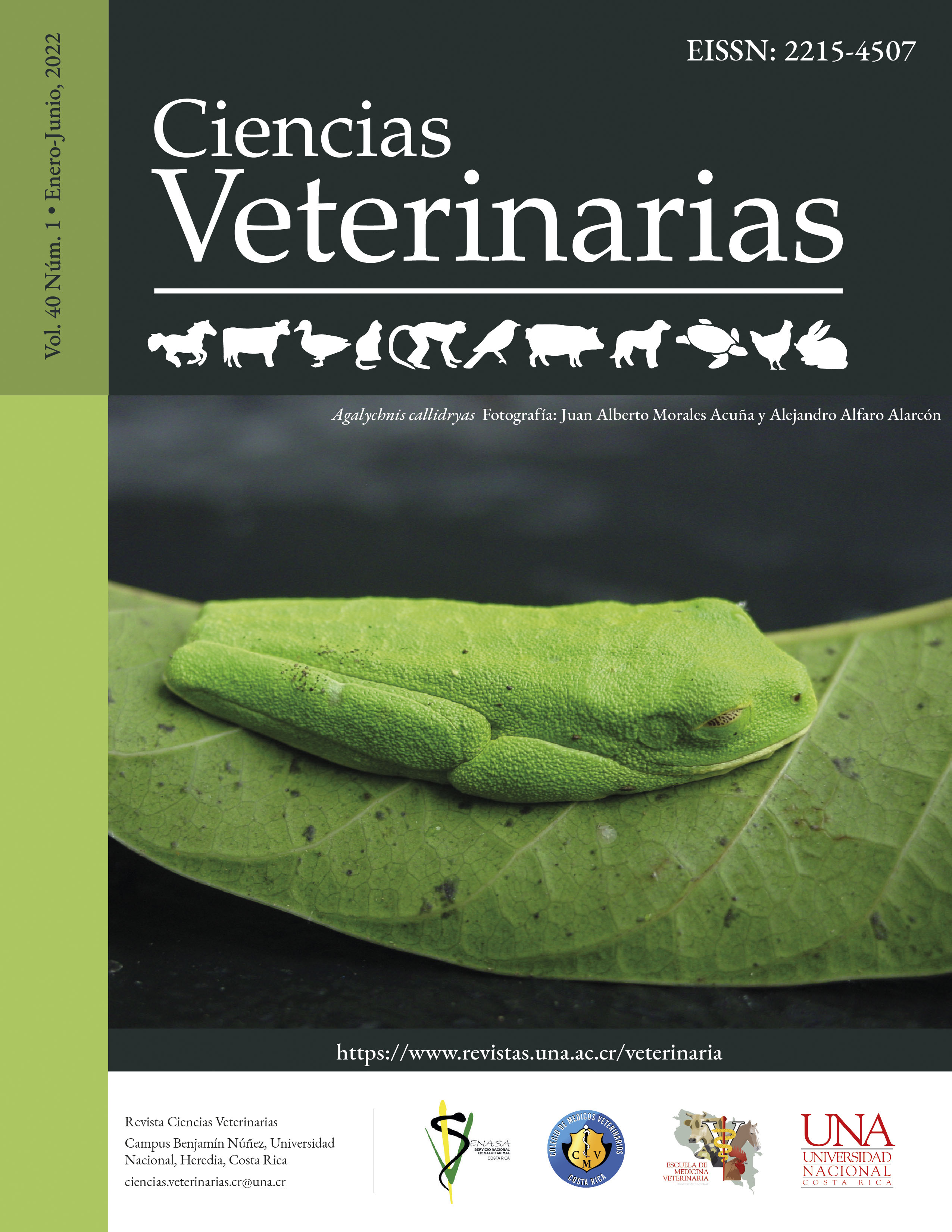Analysis of the Mechanical Resistance of the Lidia Bull Horns. Influence of the Sheathing
DOI:
https://doi.org/10.15359/rcv.40-1.4Keywords:
Lidia cattle, horns, mechanical resistanceAbstract
The bull horns are the most delicate anatomical part of this animal since its offensive and easily stressful character causes them to suffer traumatic injuries during the year prior to the show. Currently, the horn is protected with a fiberglass sleeve to protect its integrity. The present work studies the mechanical resistance of bull horns, analyzing the possible influence of the sheath on them. For this, horns have been collected from 50 fighting bulls, 4 to 5 years old, 25 of which had been sheathed 6 months before their show. The mechanical resistance of horns has been analyzed in the distal, middle, and proximal parts, using the Instron Electropulse E10000 equipment, following a methodology like that used by Horcajada et al. (2009). Three mechanical resistance tests were performed: direct compression, indirect traction, and flexo-traction; they showed high resistance of the horn, without differences between its different parts. A beneficial effect of the sheath is observed, favoring a greater thickness of the keratin envelope at the proximal part of the horn; the thickness was greater in the sheathed horns. In addition, greater resistance of the horns sheathed is observed in the indirect traction test; the horns of greater longitudinal and diameter resisted the highest pressures, and the corneal bone mostly absorbed the pressure exerted.
References
Alonso, M.E., Lomillos, J.M., González, J.R. (2016). La cornamenta del toro de lidia análisis de su integridad y efecto del enfundado. León: EOLAS Ediciones.
Aparicio-Sánchez, G. (1960). Exterior de los grandes animales domésticos. Córdoba: Imprenta Moderna.
Aparicio, J.B., Peña, F., Barona, L.F. (2000). Estudio de las encornaduras del Toro de Lidia. Ed. Junta de Andalucía. Córdoba.
Cabanas, J.M., Gualda, M.J., Rosa, M. y del Pino, J. (1994). Estudio de la composición mineral de las astas del Toro de lidia. I Congreso Mundial de Veterinaria Taurina. Zaragoza.
Calvo, L.A. (2005). Escuela gráfica de toros. Valladolid: Colegio Oficial de Veterinarios de Valladolid.
Fernández, J. (2009). Atlas gráfico de pelajes y encornaduras. Curso básico de Espectáculos Taurinos. Madrid: Ed. Colegio de Veterinarios de Madrid.
Gómez, F.J., Fernández, F.J., Pizarro, M., Carpintero, C.M., y Durán, J.M. (2009). Fractura de pitón durante la lidia, hipotéticamente asociado al enfundado de los cuernos. IX Simposio Nacional del Toro de Lidia. Zafra. Pp. 285‐288.
Gómez, A. (2011). El enfundado del Toro de Lidia. VII Congreso Mundial Taurino de Veterinaria. Cáceres. Consejo General de Colegios Veterinarios de España. Pp 23‐34.
Horcajada, F.J., Fernández, C., Ortuño, S., Pizarro, M. (2009). Diferencias físicas de comportamiento entre pitones enfundados y sin enfundar con vendas de resina de fibra de vidrio: prueba de compresión simple. IX Simposio Nacional del Toro de Lidia. Zafra. Pp. 237‐242.
Lira, F. (2008). Avances en el cuidado y protección de las defensas del Toro de lidia. Manual de manejo y nutrición del Toro de lidia. Tomo II. ITACYL Valladolid. Pp. 28-43.
Lomillos, J.M., Alonso, M.E. y Gaudioso, V. (2013). Análisis de la evolución del manejo en las explotaciones de toro de lidia. Desafíos del sector. Revista ITEA 109 (1), 49-68.
Martín, R. (1984). Estudio anatómico y biométrico de la cornamenta del toro de lidia. Medicina Veterinaria. Madrid. 1-11. Pp. 545-553.
Sañudo, C. (2009). Valoración morfológica de los animales domésticos. Ministerio de Medio Ambiente y Medio Rural y Marino. Madrid.
Pizarro, M., Carceller, H., Alonso, R., Horcajada, J., Hebrero, C. (2008a). Utilización de fundas en cuernos I: Colocación e incidencia en el reconocimiento y comportamiento. VI Congreso Mundial Taurino de Veterinaria. Murcia. Pp. 175‐ 178.
Pizarro, M., Alonso, R., Ortuño, S. y Fernández, C. (2008b). Utilización de fundas en cuernos II: Posible modificación de la estructura y consistencia. VI Congreso Mundial Taurino de Veterinaria. Murcia. Pp. 179‐182.
Pizarro, M., Horcajada, F.J., Fernández, C. y Ortuño, S. (2009). Diferencias estructurales entre pitones enfundados y sin enfundar con vendas de resina de fibra de vidrio. IX Simposio Nacional del Toro de Lidia. Zafra. Pp. 285‐288.
Real Decreto 176/1992, de 28 de febrero, por el que se aprueba el Reglamento de espectáculos taurinos. BOE núm. 56, de 5 de marzo de 1992. Pp. 7570 - 7583.
Salamanca, P. (2009). Análisis de la dureza en cuernos de machos de Lidia de tres y cuatro años de edad comparando el factor encaste. IX Simposio Nacional del Toro de Lidia. Zafra. Pp. 263‐274.
Sotillo, F., Ramírez, A.R., Sotillo, J.L. (1996). Biotipología del Toro de Lidia. En: Producciones equinas y de ganado de Lidia, Cap. XV. Zootecnia, bases de producción animal, tomo XI. Ed. Mundiprensa. Madrid.
Published
How to Cite
Issue
Section
License
Licensing of articles
All articles will be published under a license:

Licencia Creative Commons Atribución-NoComercial-SinDerivadas 3.0 Costa Rica.
Access to this journal is free of charge, only the article and the journal must be cited in full.
Intellectual property rights belong to the author. Once the article has been accepted for publication, the author assigns the reproduction rights to the Journal.
Ciencias Veterinarias Journal authorizes the printing of articles and photocopies for personal use. Also, the use for educational purposes is encouraged. Especially: institutions may create links to specific articles found in the journal's server in order to make up course packages, seminars or as instructional material.
The author may place a copy of the final version on his or her server, although it is recommended that a link be maintained to the journal's server where the original article is located.
Intellectual property violations are the responsibility of the author. The company or institution that provides access to the contents, either because it acts only as a transmitter of information (for example, Internet access providers) or because it offers public server services, is not responsible.







